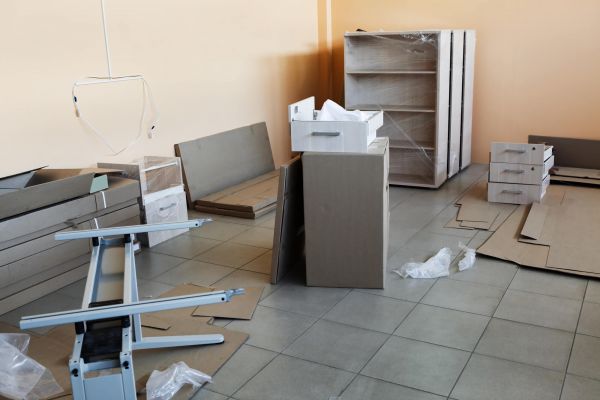Moving to a new house, while stressful, is usually a pretty straightforward process. You pack up your home, move it, unpack your stuff, and notify anyone important of your updated address. But when you’re relocating a business or office, the logistics of moving can create some unexpected hurdles.
So, which are the biggest hurdles you might face and how can you assure that your office clears them? In this post we will take a look at common office move problems like:
- Poor or no planning
- Downtime and lost business
- Failing to budget and set aside money
- Not informing people about the move
- Not fully scoping out and assessing the new location
- Unhappy employees
Read on to learn more about these six common office move problems and how to avoid them.
Problem 1: Poor or no planning
When relocating an office, you can’t wing it the way you might (but, we have to emphasize, should not) with a personal move. There’s a lot involved in an office move and failing to create a detailed plan to ensure it goes smoothly can result in difficulties in your new office and your workplace. Having a plan in place means everyone on the team knows their role and what tasks are assigned to them during the moving process, and decreases the likelihood of something being lost in the shuffle or forgotten.
Solution
As soon as you know your office will be moving, begin designating roles for every employee and start laying out the steps of your moving plan, including clearly outlining what each employee is responsible for. Set deadlines that are monitored and communicate as much detail as possible so everyone feels prepared and informed.
Not sure what to include in your moving plan? Check out 9 Steps to a Successful Office Relocation Plan.
Problem 2: Downtime and lost business
Whether it is an inability to do your jobs or assist customers, a decrease in productivity, or a drop in sales, there is a good chance you will experience some disturbances in your normal workflow during a move.
Solution
It’s basically impossible to get through an office move without any downtime or decrease in productivity. Instead of trying to aim for zero down time, consider simply reducing it as much as possible by having employees work from home or restructuring their work timelines to accommodate the relocation. You should also have your IT team in as soon as possible to get systems operational in your new office.
You can minimize disruptions by informing clients well in advance of the move and letting them know your response time may be slower than normal while you get the new office up and running. Offer alternative ways to reach you if relevant—for example, if your phone lines won’t be manned or available for a period of time, provide a live chat option.
TSI TIP: If you’re worried about flagging morale during the moving process, visit our post on 7 Ways to Keep Employees Motivated During a Relocation.
Problem 3: Failing to budget and set aside money
There is no way around it—moving costs money. Office moves can be especially costly thanks to delicate equipment and technology and large items like desks, cubicle walls, chairs, and conference tables. Failing to research how much it will cost, create an accurate budget, and book services that fit within it can mean major problems down the road, including running out of money, having to spend more than you planned, having to wait longer than expected to get your office up and running, and more.
Solution
Begin building your moving budget first thing. Thoroughly research your options and get quotes from at least 3 moving companies so you can be realistic about the expenses in your budget. You may even want to consider padding your budget slightly by adding a 10% buffer just in case you need to pay for unexpected services or in the event that something gets damaged or lost that insurance doesn’t cover.
When in doubt, it’s always better to budget high and have extra money on hand in the event that you need it. If you don’t need it you’ll have it left over to use on something fun for the office, like an office-warming party.
Problem 4: Not informing people about the move
One thing that can easily get lost in the shuffle is clearly communicating your move to the people who need to know. Whether this means failing to inform all of your clients or customers or not remembering everyone who will need your updated address, such as business partners, suppliers, or service providers, not informing the right people sufficiently in advance can result in big problems later on.
Solution
If you aren’t already doing it, start making a list and keeping track of everyone who has your business’s address. As soon as you know that you know you are moving and when and where you are moving to, inform your clients or customers as well as your surrounding community via all your different communication channels. Send periodic reminders up until moving day, including one on the day you have officially moved in. Lastly, be sure to update the address on your website, social media accounts, and Google business profile so customers and potential clients can find you easily.
Get our advice for How to Announce a Commercial Move in 4 Simple Steps.
TSI TIP: Don’t forget to set up mail forwarding with USPS, and to ask the new tenants of your office to inform you of anything that mistakenly gets delivered there so you can arrange for pickup.
Problem 5: Not fully scoping out and assessing the new location
While your new office space may be a big upgrade, moving in without thoroughly evaluating the space to confirm that it meets all of your needs or whether changes will need to be made to accommodate your workflow is another common mistake.
Solution
Talk to your office manager, employees, IT team, and business partners before you decide on a new location to ensure the new space isn’t missing anything vital. Look over the floor plans and take a few walkthroughs ahead of the move with key members of your team to confirm the new setup is going to work. If not, make any necessary adjustments before moving day. This will also help you limit any downtime by identifying and addressing any issues ahead of the move.
Problem 6: Employees are unhappy with the move
Moving an office can be a major inconvenience for your employees. For some employees, a new office may mean a longer commute, which will affect other areas of their lives—wake up times, morning routines, childcare, etc. And in certain cases—especially out-of-town office relocations—employees may feel or actually be unable to make the move with the office.
Solution
Get employees on board early in the process so that they don’t feel blindsided, and make sure you provide them with any support or services they need, such as accommodating working from home. Communicate openly throughout the moving process and give them space to express their concerns or flag any issues they have with the move—then do your best to address them. This may mean helping employees with transportation, childcare services, monetary incentives, or offering them a relocation package if you’re moving to a new city or state.
Need more help with getting your employees on board? Visit our blog post on 10 Rules for Successfully Relocating Employees.
Conclusion
An office move can be complicated and it takes relatively little to throw a wrench in the works. To iron out any wrinkles in the moving process and ensure a successful transition, make sure that you:
- Plan ahead
- Work to limit downtime
- Make a budget and stick to it
- Communicate the move
- Thoroughly vet the new office space to confirm it is ready to work in as soon as you move in
- Address employee concerns early
Moving Your Office?
TSI offers easy and affordable commercial office relocation services for every business.




